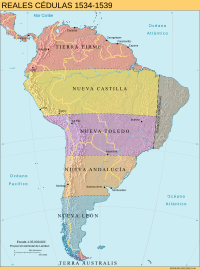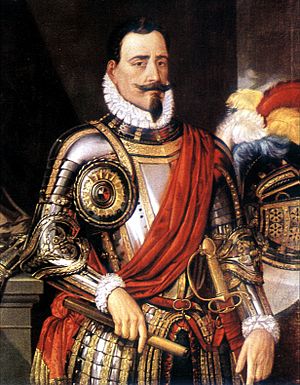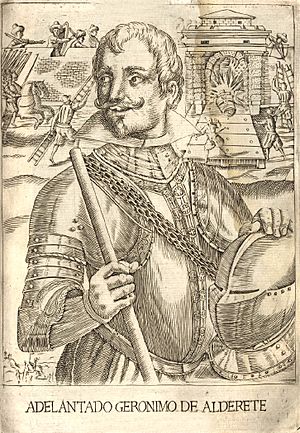Governorate of Terra Australis facts for kids
Quick facts for kids
Governorate of Terra Australis
Gobernación de la Terra Australis
|
|||||||||||||||
|---|---|---|---|---|---|---|---|---|---|---|---|---|---|---|---|
| 1539–1555 | |||||||||||||||
|
Flag
|
|||||||||||||||

Map of the Spanish Governorate of Terra Australis (1539-1555), later it was incorporated into the Governorate of Chile
|
|||||||||||||||
| Status | Governorate of the Crown of Castile | ||||||||||||||
| Official languages | Spanish | ||||||||||||||
| Religion | Catholicism | ||||||||||||||
| Government | Monarchy | ||||||||||||||
| Governor | |||||||||||||||
|
• 1539-1540
|
Pedro Sancho de la Hoz | ||||||||||||||
|
• 1540-1553
|
Pedro de Valdivia | ||||||||||||||
|
• 1554-1555
|
Jerónimo de Alderete | ||||||||||||||
| Historical era | Spanish Empire | ||||||||||||||
|
• Created by Capitulación de Pedro Sancho de la Hoz
|
1539 | ||||||||||||||
|
• Incorporated to the Governorate of Chile
|
1555 | ||||||||||||||
| Currency | Escudo | ||||||||||||||
|
|||||||||||||||
The Governorate of Terra Australis was a large area controlled by Spain. It was created in 1539 by the Crown of Castile. This territory was given to Pedro Sánchez de la Hoz.
It included all lands south of the Strait of Magellan, reaching all the way to the South Pole. Its eastern and western borders were set by important agreements called the Treaty of Tordesillas and the Treaty of Zaragoza.
At that time, people thought Tierra del Fuego was part of a huge southern continent called Terra Australis. It wasn't until much later that explorers found out more about these lands. For example, in 1603, Admiral Gabriel de Castilla sailed south from Valparaíso, Chile. He reached 64 degrees south, discovering the first Antarctic lands. Cape Horn was not discovered until 1616.
Contents
History of the Governorate
The Governorate was created by King Charles V of Spain. He named Pedro Sánchez de la Hoz as its first governor. He was also made captain general and chief justice. This meant he had a lot of power once he took control of the lands.
Firstly, I give you license and power to the said Pero Sancho de Hoz so that for us, and in our name and that of the royal crown of Castile, you may sail with the said ships that you thus offer to make for the said South Sea, where the said marquises don Francisco Pizarro, and adelantado don Diego de Almagro, and don Pedro de Mendoza, and Francisco de Camargo have the said governorships, to the said strait of Magellan, and the land that is on the other side of it; and on your way or return, you will discover all that coast on the side of the said strait, without entering into the limits and place of the islands and land that are given in government to other people to conquer, and to govern, nor to rescue, except for the sustenance of the people you will carry, so long as you do not touch the limits and demarcation of the Most Serene King of Portugal, our brother, nor the Malucos, nor the limits which, by the last contract and commitment, were given to the Most Serene King. Item, we promise you that, made the said discovery of the other part of the said strait, or of some island that is not in a foreign place, we will do you the mercy of your services; and while we are informed of what you will thus discover, you will be our governor of it. [...] Date in Toledo on the 24th day of January of the month of 1539 years.
However, Pedro Sánchez de la Hoz never fully took control. On August 2, 1540, he gave his rights to Pedro de Valdivia. This happened in Atacama, after de la Hoz had tried to harm Valdivia several times.
Valdivia was already the governor of Terra Australis. Later, he became governor of Chile. His Chilean territory stretched from 27 degrees south latitude to the Strait of Magellan. Because of this, Valdivia wanted to explore the Strait and combine Chile with the Terra Australis Governorate.
In 1553, Valdivia sent Jerónimo de Alderete to Spain. Alderete's job was to get the king to expand Valdivia's governorship. Valdivia wanted to merge his Chilean lands with the Terra Australis territory he had from de la Hoz. Sadly, Valdivia died on December 25, 1553.
Terra Australis Joins Chile
Jerónimo de Alderete succeeded in his mission in Spain. He got the king to grant him the territories south of the Strait of Magellan. He asked for the lands "from the said Strait of Magellan along the coast of the southern sea up to three hundred leagues." It is believed that Valdivia had given Alderete permission to make this request.
The king granted Valdivia's governorship to extend to the Strait of Magellan. He also approved Alderete's request. This was done in two royal decrees on September 29, 1554. The decree about the southern land stated: "It has seemed to us to grant as we hereby grant to the said Captain Geronimo de Alderete the governorship of the land that as the said strait is on the other side of the said Strait of Magellan." The Council of the Indies would later define the exact borders of Alderete's part of Terra Australis.
However, news of Pedro de Valdivia's death reached Spain. Because of this, Alderete inherited all of the Terra Australis territory, not just the part he asked for. On May 29, 1555, another royal decree was issued. This decree gave Alderete the provinces of Chile and its Patagonian lands. It also officially joined the Terra Australis territories to the Kingdom of Chile. Alderete was named governor of Chile. The document asked him to "take possession in our name of the lands and provinces that fall within the demarcation of the Crown of Castile, on the other side of the said strait."
In late 1554, King Charles I wrote to the Council of the Indies. He said that Alderete should send ships from Chile to explore Terra Australis. He noted that Alderete should not go in person to conquer or settle it yet. This was because he needed to focus on Chile first.
For about eight months, from September 1554 to May 1555, the regions of Terra Australis near the Strait of Magellan had a different ruler than Chile. Then, they were fully joined with Chile when Alderete became its governor. Sadly, Alderete died of yellow fever in Panama on April 7, 1556, while returning to Chile.
His successor, García Hurtado de Mendoza, sent Juan Ladrillero in 1558. Ladrillero's mission was to claim both sides of the Strait of Magellan for Spain. When Francisco de Villagra was appointed governor, he was also asked to claim the lands south of the Strait. This royal decree set the South Pole as the southern border of the Governorate of Chile. This was based on the rights transferred from the Governorate of Terra Australis.
Spanish Governorates in South America

After Spain and Portugal divided South America, Spain organized its lands into several large areas. These were called governorates. Before the Viceroyalty of Peru was established, there were six main Spanish territories:
- Province of Tierra Firme: This included the Caribbean Coast, Central America, and parts of Colombia and Mexico.
- Governorate of New Castile: This stretched from the border of Ecuador and Colombia down to Cuzco.
- Governorate of New Toledo: This covered the southern part of the Inca empire, reaching towards central Chile.
- Governorate of New Andalusia: This area was not fully conquered by Spain for many years.
- Governorate of New León: This was the southernmost part of the continent, reaching the Strait of Magellan.
- Governorate of Terra Australis: This included all lands from the south of the Strait of Magellan to the South Pole.
This way of dividing the land helped Spain manage South America for several decades. These governorates were officially ended in 1544. King Charles I then sent Blasco Núñez Vela to govern the new Viceroyalty of Peru, which replaced the old governorates.
Borders of Terra Australis
See also
 In Spanish: Gobernación de la Terra Australis para niños
In Spanish: Gobernación de la Terra Australis para niños





